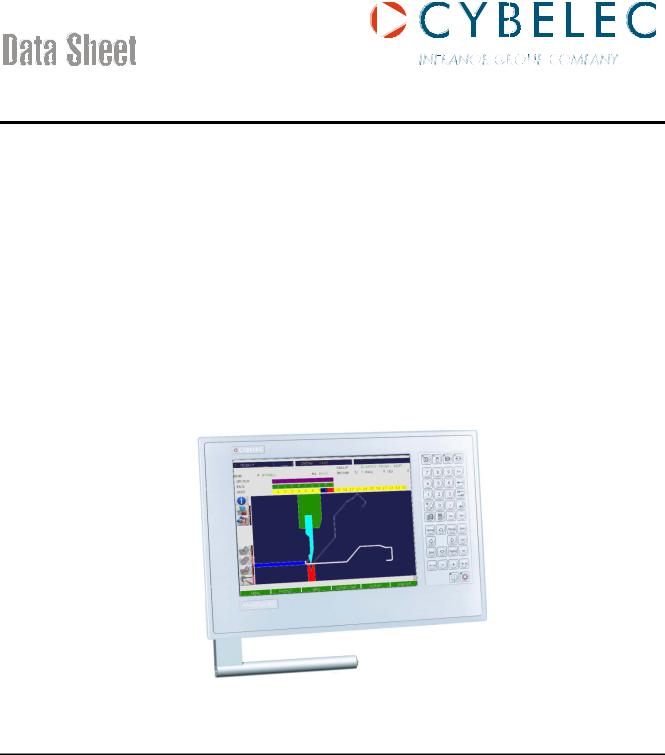cybelec 15T Data Sheet

ModEva™ 15T
ModEva is a range of numerical control units intended specifically for sheet metal working.
Depending on the software installed, ModEva can be used on synchronized or non-synchronized press-brakes of the upstroking or down-stroking type.
ModEva numerical control units can control up to 18 axes of which 2 are synchronized hydraulic axes especially intended for press-brakes.
The numerical control is composed of 2 main elements:
•The programming console.
•The CNC (Computerized Numerical Control).
The programming console is located within the operator's reach, generally fixed to a swiveling arm; the CNC is placed inside the electric cabinet.
The CNC is available in 2 rack formats.
•Rack version C (Compact): This is a small, very compact rack, convenient for many situations.
•Rack version M (Medium): This is a bigger rack permitting a varied combination of configurations.
The software enables manufacturers to configure the axes, the inputs/outputs and the auxiliary functions according to their needs.
Versions
PS |
Version for synchronized press-brakes. |
PC |
Like the PS but for press-brakes with mechanical (or hydraulic) stops and beam control with a linear |
|
encoder. |
ModEva CNC /C |
ModEva CNC version "C" (Compact): can control up to 4/6 axes or even 18 with CAN axes*. |
ModEva CNC /M |
ModEva CNC version "M" (Medium): controls up to 12/14 axes or even 18 with CAN axes*. |
* see definitions of the axes and configurations further on in the document.
CDS_ModEva_15T_EN_V2.5.docx5 |
Aug 2014 |
1/ |

ModEva Range
ModEva is a modular range with a choice of:
•1 programming console 15” touchscreen.
•2 programs (2D or 3D) and 1 Windows XP emb. operational system.
•2 different rack sizes depending on the number of axes and the desired technology (analog or CAN).
Definitions:
Hydraulic axes: |
An analog axis especially intended for controlling the beams (Y1-Y2). These two axes are on the |
Analogical axes: |
NPU. |
Axes for which position is given by an incremental sensor and instructions are provided by the CNC |
|
|
via a ±10V DC analog voltage. One also corresponds to an analog interface axis. These axes are |
CAN axes: |
controlled by boards called NMX / NSX. Each of these boards controls 2 axes. |
Axes for which positioning information is handled through a CAN bus. |
|
|
These axes require an NCX board on the CNC side and a CAN interface on the servo-amplifier side. |
|
An NCX board can control up to 8 axes. The number of CAN axes is controlled as an option. |
|
The ModEva CNC can be equipped with a maximum of 2 NCX axis boards. |
NMX: |
A master board for 2 analog axes. A master board controls up to 3 NSX slave boards. |
NSX: |
A slave board for 2 analog axes. A slave board in all cases requires an NMX board. |
NCX: |
CAN board for a maximum of 8 CAN axes. This board can handle various protocols according to the |
|
type of servo-amplifier used. It is possible to combine CAN and analog axes. |
Configurations of CNC axes
Rack version |
CNC / C (Compact) |
|
|
|
CNC / M (Medium) |
|
|
||||
No. of axis boards |
|
2 |
|
|
|
|
5 |
|
|
||
Axis position (slot No) |
0 |
|
1 |
|
0 |
1 |
2 |
|
3 |
4 |
5 |
|
NMX |
|
- |
|
NMX |
NSX |
NSX |
|
|
|
|
The most common |
NMX |
|
NSX |
|
NMX |
NSX |
NSX |
|
NSX |
|
|
NMX |
|
NLR |
|
NMX |
NSX |
NSX |
|
NLR |
|
|
|
configurations |
|
|
|
|
|
||||||
NCX |
|
- |
|
NMX |
NSX |
NSX |
|
NLR |
NMX |
|
|
|
|
|
|
|
|||||||
|
NCX |
|
NLR |
|
NCX |
NLR |
|
|
|
NMX |
NSX |
CDS_ModEva_15T_EN_V2.5.docx5 |
Modification rights reserved |
2/6 |
